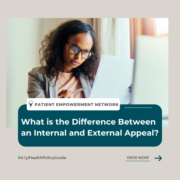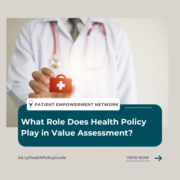What is the Difference Between an Internal and External Appeal?
What Is the Difference Between an Internal and External Appeal? from Patient Empowerment Network on Vimeo.
Joanna Morales, Esq, CEO of Triage Cancer explains the difference between an internal and external appeal and encourages patients to appeal if they ever need. She shares that only .2% of claims were appealed in 2019 out of more than 40 million.
See More from the Health Policy Activity Guide
Transcript
Diahanna Vallentine:
What is the difference between an internal appeal and an external appeal?
Joanna Morales: So, the process for appealing depends on the type of health insurance plan that you have, but if you have an individual health insurance plan or you get a health insurance plan through your employer, an internal appeal is when you go back to the insurance company and you ask them to reconsider. So it’s internal to the insurance company and asking them to take another look to see if they’ll cover your care, but as a result of the Affordable Care Act, every state now also requires those insurance companies to provide access to an external appeal, where you get to go outside of the insurance company to an independent entity, and they’re going to take a look to see whether or not the care that’s been prescribed to you is medically necessary. And if they decide that it is, that decision is binding on the insurance company, which means that the insurance company is going to have to cover that care, and we know that about 50% of the time on average across the country, external appeals are successful for patients. Unfortunately, very few patients actually go through the appeals process, we know based on the data that in 2019, just looking at market place plans, more than 40 million claims were denied, but only .2% of those claims were appealed and not even to the external appeals level, just through the internal appeals process. So, when you think about 50% of the time external appeals are successful, when we’re talking about 40 million claims, we could estimate that 20 million of those claims were patients who either didn’t get the care that they were prescribed by their healthcare team because they couldn’t afford to pay for it out of pocket or they paid for it out of pocket. And when we’re talking about the financial burden of a cancer diagnosis, not appealing, those denials is certainly contributing to that financial burden, and so we want people to understand their rights to appeal.
Diahanna Vallentine:
Can we go back really quickly to the appeal process, have a quick question, So every state then has an external appeal program, will every patient get notification that they can go outside of the internal appeal process, would they know that?
Joanna Morales:
Part of the law’s requirements when a patient is sent a denial letter from the insurance company, that denial has to include the information on how to actually go through the external appeals process, so there is a notice requirement. Now, you have to be savvy as a consumer because that notice might be in small print or on the back side of the letter, but most insurance companies do provide this notice, but patients still need to make sure that they’re following the insurance company’s rules for how to access the appeals process, and that includes following the deadlines. And unfortunately, I think when patients are getting a lot of mail from insurance companies and bills from their providers, there’s a tendency to avoid dealing with those bills for a while, and that the mail can pile up, but it’s important to actually open your mail because there might be key deadlines that you’re missing, if you’re putting off reviewing those bills.










